|
|
The
Gerbils Colors
In the province of Quebec, you can
only find a fraction of all gerbils color available in the United States.
There's about 40 differents gerbil colors in the world and here you can only
find 8 different colors in petshops. In my kennel, you can find alot more!
All
the color names used in the website are the one used mostly in the United State.
To know more about Gerbil color names, you can use the Color
Dictionary.
To
know more about history in discovery of Gerbil colors (GerbilShows UK)
About
blue gerbils (dd) (GerbilShows UK)
How
does it work?
To
know more about genetic and how to predict the colors in breeding, visit the Genetic
page.
Artistic
Gerbil Color Interpretation
Click
on the names to see the description.
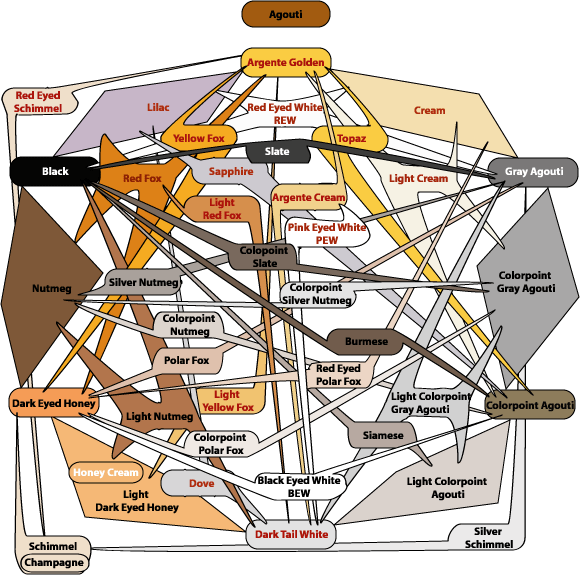
The
Spotes
|

|

|
Agouti
|
A-C-E-G-P |
|
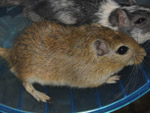
|
This
is the wild color of the gerbil. It is brown with orange and grey trough
the airs. The eyes are black and the belly is white
Pigments:
The eyes are black and the skin is pinkish/greyish. The arms will be
lighter, pink.
Fuzz:
A nice brown appears and also the black tip of the hairs.
The
Agouti gerbil keeps the color all its life.
Agoutis can have different coloration
depending of the recesives genes they carry. On the left picture below,
you can see a gerbil carring the "e" gene (top) and next
to a more regular agouti (below). This can also be seen with the
"g" and "ch". |
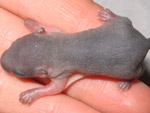 |
|
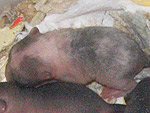
|
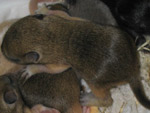 |
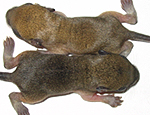 |
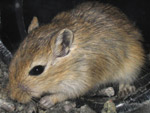 |
|

|

|
Argente
Golden
|
A-C-E-G-pp |
|
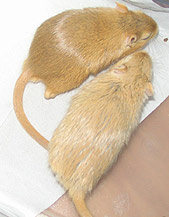
|
The Argente Golden is rich yellow/ beige. The eyes are red
and the belly is white. The "pp" gene remove the black pigment form
the fur and the eyes. It is pretty hard to distinguish from the Argente Cream.
The Golden always seems to have some grey under the golden. In the top left
picture, it's the top one.
Pigments:
The eyes are pink. You can see some grey on its back with the yellow after some
days of age.
Fuzz: A nice yellow color
with still some grey on the rump. This is the main characteristic to distinguish
between the Argente Golden and Cream.
On the picture below, you can
see 2 Argente Golden. The one on the left is a regular Argente Golden. The
one on the right is a Argente golden carring the "e" gene. He is
not a Yellow fox because the under coat is gray as it is suppose to be in a
regular Argente. Notice how hight the white goes on the right gebril. This
is one of the caracteristic of the "ee" gene. |
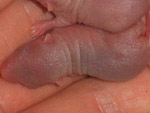 |
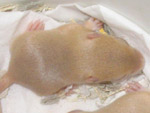 |
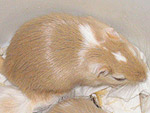 |
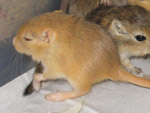 |
|
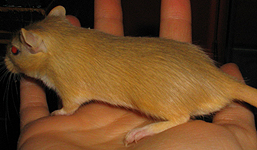 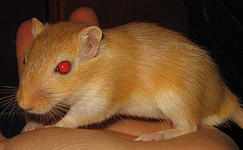
|
|

|

|
Topaz
|
A-Cc[chm]-E-G-pp |
|
|
The Topaz is between the Argente Golden and the Argente Cream.
But as those 2 colors are already hard to distinguish, I got lots of
difficulties myself to say which one it is. We could say that the topaz have the
same taint then the Argente Golden but without the grey on the rump. The eyes
are red and the belly is white.
Pigment:
The eyes are pink. The color appears faster then the Argente Cream.
Duvet: The color look like an
Argente Cream but more yellow.
|
|
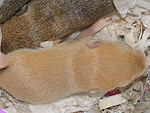 |
|
|
|
 |

|
Argente
Cream
|
A-Cch-E-G-pp |
|

|
The Argente Cream is similar to the Argente Golden but
lighter. The eyes are red and the belly is white. In additon to the pp gène,
the c[h] gene light up the fur color making the grey on the rump much lighter.
It is quite hard to ditinguish both color unless you got both next to each other.
The yellow is richer in the Argente Golden. On the top left picture, it's the
bottom one.
Pigment:
The eyes are pink and the skin stays pink longer the Argente Golden and topaz
before it gets yellow/cream.
Fuzz: It is going to be
light creamy beige without grey on the rump. |
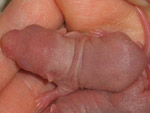 |
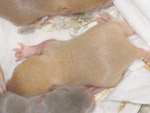 |
|
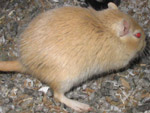
|
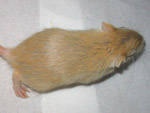 |
 |

|
Black
|
aa
C-E-G-P- |
|
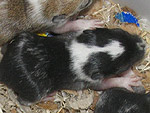
|
The black is totally black. The white marks on the front paws
and under the chin are totally normal and are a characteristic of that color.
The aa gene makes the color the same all over the gerbil body. The eyes are
black and the belly is black too.
Sometimes, the black gerbil may seem slate. But in some
cases, it can be the recessives gene that carries the gerbils that produce that
color. A gerbil with aaCchEGPp will be lighter then a pure black gerbil with
aaCEGP.
Pigment:
The eyes are black. We can see some grey/brown show rapidly in the first few
days. The belly may seem pink at first but it will become the same color then
the backside after a few more days.
Fuzz: It becomes black
and shiny |
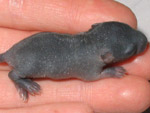 |
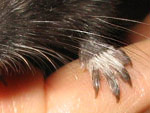 |
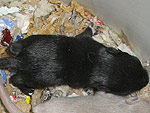 |
|
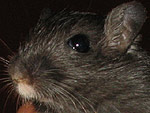
|
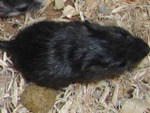 |
 |

|
Lilac
|
aa
C-E-G-pp |
|
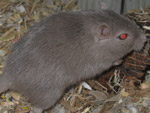
|
The Lilac is a dark plain grey and it's possible to see the
white marks on the paws and the chin as on the black gerbil. The pp gene removes
the black pigment in the fur and the aa gene makes the color even on all the
fur. The eyes are red and the belly is the same color then the back.
Some says that colors with pp have smaller eyes. I agree but
it doesn’t make them bad gerbils for this reason!
Note on the picture on the left, below, often, the light of
the camera makes the color very different from one picture to the other. Also,
when they are approximately 1 month, they moult and they get pretty fuzzy and
the fur seem more light then the real color. You can observe that in black
gerbils too.
Pigment:
The eyes are pink. The grey color become rapidly visible compared to the
Argented and the Dove.
Fuzz: A grey lightly
purplish. It will keep this color all its life. |
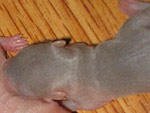 |
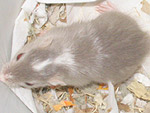 |
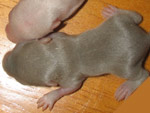 |
|
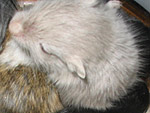
|
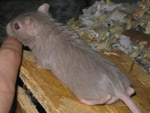 |
 |

|
Sapphire
|
aa-Cc[chm]
E-G-pp |
|
|
The Sapphire is evenly grey in-between the dove
and the lilac. More light then the lilac it can easily be confused with the dove
especially when the gerbil is still young. I feel like it is some kind of bluish
as we say that the lilac is a little purplish.
Pigment:
The eyes are pink. The grey color appears more rapidly then the Dove.
Fuzz: The grey seems to be
darker on the head. |
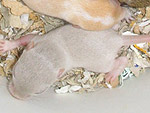 |
|
|
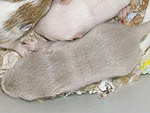 |
|
|
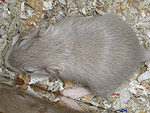 |
 |

|
Dove
|
aa
Cc[h]
E-G-pp |
|
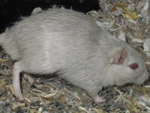
|
The Dove is a nice light grey. The eyes are red
and the belly is grey as the back. The grey color is softer then the Lilac.
Pigment:
The eyes are pink. The baby Dove will stay pink and the almost white for a while
before that the grey become apparent. If there is a white in the same litter,
you'll see that he becomes grey and if there is no white one, you may think you
got a white one!
Fuzz: He will be a nice
light grey, very easy to distinguish from the dark grey of the lilac. On the
center/right picture, you can see the head of a lilac next to the dove.
|
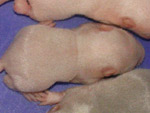 |
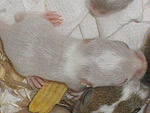 |
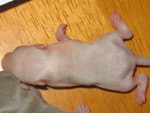 |
|
|
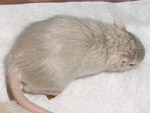 |
 |

|
Pink
Eyed White (PEW)
|
A-c[h]c[h]
E-G-pp
|
|
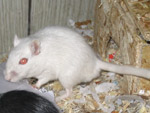
|
The Pink Eyed White is totally white with pink
eyes. The double c[h] and pp, light the fur to white.
Pigment:
The eyes are pink. The skin will be pink and will stay pink a while before that
white fur appears.
Fuzz: It
will become totally white.
Note:
PEW can be spotted, it is |
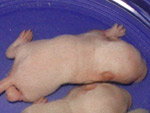 |
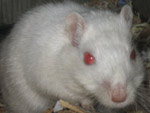 |
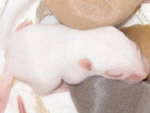 |
|
|
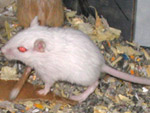 |
 |

|
Dark
Tail White (DTW)
|
A-c[h]c[h]
E-G-P- |
|
|
The Dark Tail White is almost totally white
except the tail is dark. The tail begins to become dark around the age of 4 to 6
months.
Pigment:
The eyes are pink. The skin will be pink and will stay pink a while before that
white fur appears.
Fuzz: It
will become totally white.
4-6 months: At that time, the tail
will begin to change to brown/grey coloration. It's impossible, before that
time, to know if a baby PEW will turn DTW. (Except with parent’s genetic) |
 |
|
|
 |
|
|
 |
 |

|
Dark
Eyed Honey (DEH)
|
A-
CC ee
G-
P- |
|
|
The Dark Eyed Honey is deep orange. The eyes are
black and have a more pronounce almond shape. The belly is white and goes higher
on the side, then a normal agouti gerbil. The ee gene makes the yellow pigment
more intense.
Pigment:
The eyes are black. The babies have a very typical pigmentation. The skin around
the eyes, the ears and the extremities is dark. All colors with ee will have
this characteristic. The skin elsewhere will be pink
Fuzz: It
will be orange and will stay that color as he age but may become darker over
time.
|
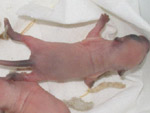 |
|
|
|
|
|
|
 |

|
Light
Dark Eyed Honey (LDEH)
|
A-
Cc[h]/c[chm]
ee
G-
P- |
|
|
The Light Dark Eyed Honey is orange cream. The
eyes are black and the belly is white. Like the DEH, the white belly goes higher
on the side of the gerbil. The ee gene makes the yellow pigment more intense and
the c[h] gene makes it lighter.
Pigment:
The babies have the same typical pigmentation as the DEH. The fur will appear
the same tint then the DEH but lighter.
Fuzz: It
will be light orange with few brown ticking. The color will stay the same as the
gerbil ages but may get darker a little.
|
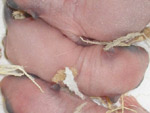 |
|
|
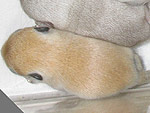 |
|
|
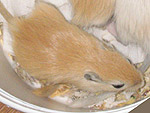 |
|

|

|
Honey
Cream
(Spotted
Light DEH)
|
A-
Cc[h]/c[chm]
ee
G- P- Sp
|
|
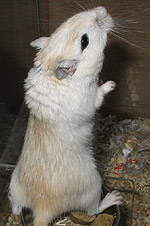
|
The Honey Cream has a creamy white coloration
with trace of orange on the back. it's in fact, a Light DEH with white spots. It
is possible to see the white diamond shape on its forehead. The eyes are black
and the belly is white. The ee gene is very sensitive to decolouration. With the
presence of Sp (spotting gene) it becomes very white. The eyes are black and the
belly is white.
Pigment:
Like the DEH, the skin of the eyes and ears will be black. But the paws will be
pink due to the spotting gene.
Fuzz: The
color will be the same as adults and the orange fur may become more orange over
time.
|
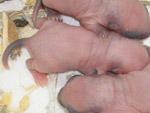 |
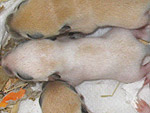 |
|
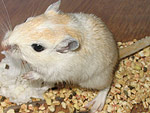
|
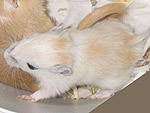 |
|

|

|
Nutmeg
|
aa-
C- ee
-G
P- |
|
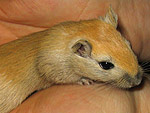
|
The Nutmeg is brown with black ticking and an
orange undercoat. You can easily see it by pushing the fur backward. The belly
is the same color as the body and the eyes are black.
Pigment:
Almost identical to the DEH but maybe a little more orange.
Fuzz: Very
orange a little darker then the DEH. It is difficult to see the difference. (Both
gerbils on the right picture are Nutmeg, sorry, no comparison.)
1 month:
Still very orange, the belly won't be as white as the DEH or Light DEH.
2 month: A drastic color
change occurs to the young gerbil. It's one of the strangest moult there is in
the gerbils color world. The nice orange begins to turn to a brown ticking. The
process begins on the cheeks, goes down the chin and the sides, goes up in the
back and finish on the top of the head! For
more infos about Nutmegs, visit Gerbilsite.com |
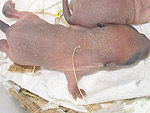 |
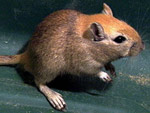
|
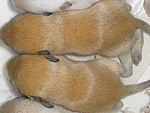 |
|
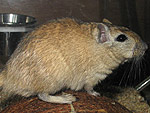
|
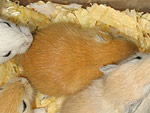 |
|

|
|
Silver
Nutmeg
|
aa-
C- ee
-gg
P- |
|
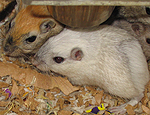 |
The Silver Nutmeg grey with black ticking. The
eyes are black and the belly is the same color then the body.
Pigment:
Same characteristics then the DEH but lighter.
Fuzz: Hard
to define, peach, pinkish and greyish all at the same time!
1 month: Still
the same orange pinkish color. Less grey.
2 month: Like the Nutmeg, a
drastic change occurs. It will turn from cream to a grey ticking following the
same process then the Nutmeg. |
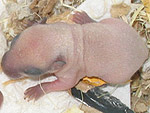 |
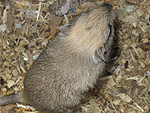
|
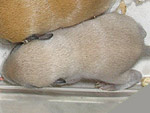 |
|
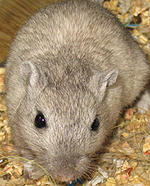
|
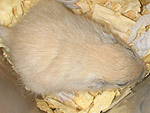 |
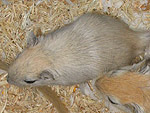 |
|

|
|
Slate
|
aa-
C- E
gg
P- |
|
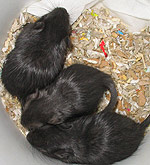
|
The
Slate is a very dark grayish brown. It's almost black, but faded brown shine
lights up the black coloration just a little. The coloration can be different
from a gerbil to the other, concidering the recesive genes. The eyes are black
and the belly is the same color then the rest of the body. Some white marks are
present on the chin and on the front paws, just like the black gerbils.
Pigment:
Same as the black Fuzz:
Looks like a lot like the black gerbil on the first look, but a brown shine
makes you doubt about the real color. On the pictures on the right, you can see
each Slate next to regular black to observe the difference. 1
month: It may be very difficult to see any difference. On the top
picture on the left, the center gerbil is a Slate. Belive me! Adult:
The same coloration stay. And it's always as hard to tell if it's really a Slate. |
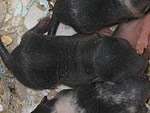 |
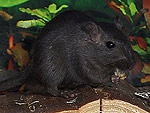
|
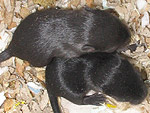 |
|
|
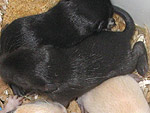 |
|

|
|
Polar
Fox
|
A-
C- ee
-gg
P- |
|
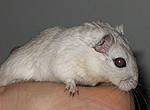 |
The Polar Fox is a light ticked grey. The
eyes are black and the belly white
Pigment:
Same characteristics then the DEH but lighter.
Fuzz: Hard
to define, peach, pinkish and greyish all at the same time!
1
month: Still
the same orange pinkish color.
2 month: Like the Nutmeg, a change occurs. It will turn from cream to a grey ticking following the
same process then the Nutmeg and silver nutmeg but lighter.
(from
left to right) Spoted Polar Fox, Polar Fox, Silver Nutmeg
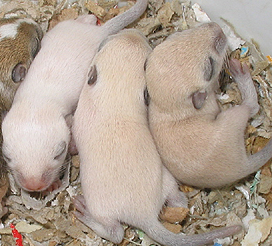
|
 |
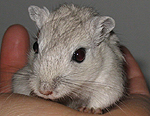
|
|
|
|
|
|
|
|

|

|
Schimmel
|
A-
CC
efef
G-
P- |
|
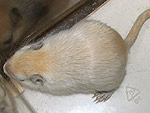
|
The adult Schimmel is white with an orange tail.
As the gerbil ages, the tail will lighten. The eyes are black and the belly is
white. The fading gene (ef) makes the orange baby turn white at 2 months old.
Pigment:
Will be similar to the Light DEH. The paws will be dark.
Fuzz: To
distinguish the Schimmel from the Light DEH, ... it's hard at first. it's as if,
when you look in the fur, the orange color was not to much confident... As if
the tip of the hairs were a creamy color.
From 50 days, the neck begins to fade. It's the proof that it really is a
schimmel. (picture top left) |
 |
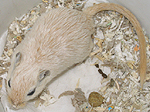
|
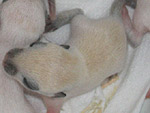 |
|
|
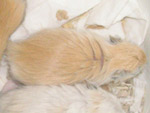 |
|

|

|
Champagne
(Spotted
Schimmel)
|
A-
CC
efef
G-
P- Sp |
|
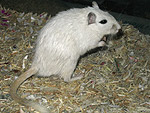
|
Like the Schimmel, the Champagne loses all its
color but keep an orange tail. Because it's in fact, a spotted Schimmel, you can
see a white tip on the tail. You can also see the diamond shape on its forehead
when the gerbil is younger.
Pigment:
Like the DEH, the skin of the eyes and ears will be black. But the paws will be
pink due to the spotting gene.
Duvet: It
will be almost white with a little of orange trough the fur. The Champagne will
be more light then the Honey cream to this stage.
Around
50 days old, the orange color will almost totally disappears leaving only an
orange tail with a white tip! |
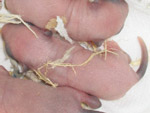 |
|
|
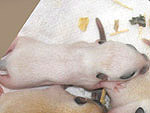 |
|
|
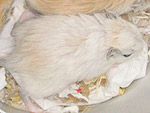 |
|

|

|
Black
Eyed White (BEW)
|
A-
c[chm]c[chm]- e
e/ef
-gg
P- |
|
|
The Black Eyed White gerbil doesn’t need any
explanation! It’s a white gerbil with black eyes. The ears and the nose will
be slightly grey.
Pigment:
Very light with black/grey eyes. Paws and ears are pink too.
Fuzz: I
can't say any more that it will be a white gerbil with black eyes!
|
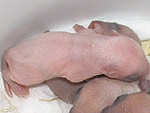 |
|
|
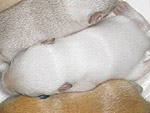 |
|
|
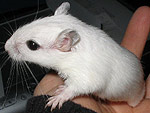 |
|

|

|
Burmese
(Similar
color: Colorpoint Slate)
|
aa
c[chm]c[chm]
E-
G-
P- |
|
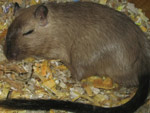
|
The
Burmese is a dark solid brown with black points. The tail, paws and ears will be
black. There may be some white on the paws and chin as in the black gerbil. The
eyes are black and the belly is the same color the the back.
The
"aa" makes the gerbil black but the double "c[chm]" makes
the center of the body lighter then the points.
The
colors produced by the "c" genes are temperature sensitive. This means
that more the temperature is low the darker are the points. That's why the
babies don't have any colored points. Babies tend to pass long hour in the
warmth of mom.
Pigment: The eyes won't be
as black as with an agouti but grey. The skin will be /pinkishgreyish.
Fuzz: It
will be solid brown/grey with no dark points. 1
month: It will be solid brown with almost no dark points
beside the tail. 2 month:
Solid brown body with black points. |
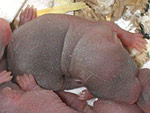 |
|
|
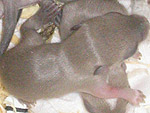 |
|
|
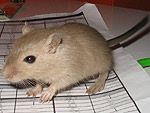 |
|

|

|
Siamese
|
aa
c[chm]c[h]
E-
G-
P- |
|
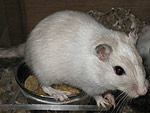
|
The
Siamese is light brownish/gray with dark points. The eyes are black but with a
slight redish color when place in the light.The belly is the same color then the
back. The c[h] genes light up the color.
Pigment: The eyes won't be
as black as with an agouti but grey. The skin will be /pinkishgreyish.
Fuzz: It
will be solid light brownish/gray with no dark points. 1
month: It will be solid light brownish/gray with almost no dark
points beside the tail. 2
month:
Solid brownish/gray body with black points. |
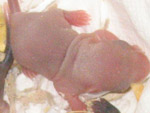 |
|
|
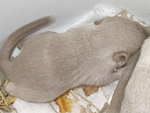 |
|
|
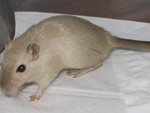 |
|

|

|
Colorpoint
Agouti
|
A-
c[chm]c[chm]
E-
G-
P- |
|
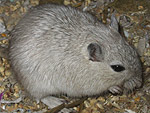
|
The
Colorpoint Agouti is gray with black ticking like salt and pepper. The tail is
almost the same color as the one of a normal Agouti with some yellow hairs in
it. The eyes are black. The belly is white. The doucle c[chm] gene keeps the
point dark and light up the center of the body. In theory, the points should
look like an agouti color.
Pigment:
Fuzz: Gray with black ticking As
it gets colder, the ticking become darker. |
|
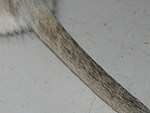
|
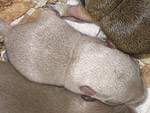 |
|
|
|
|

|

|
Light
Colorpoint Agouti
|
A-
c[chm]c[h]
E-
G-
P- |
|
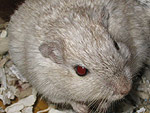
|
The
Light Colorpoint Agouti is light gray with brown ticking. The eyes are black but
may seem red depending of the light. The belly is white. The adding c[h] gene
make the gerbil lighter.
Pigment: The eyes are more
light gray the black. The skin is pink and stays pink just until fur grows.
Fuzz: may look white at first
but then some light gray appears. The tail has an "arrow" of brown on
the tip. (see the right/center picture) As
it gets colder, the ticking become darker. |
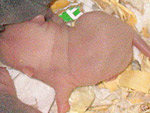 |
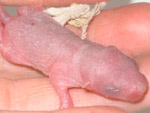
|
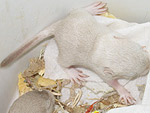 |
|
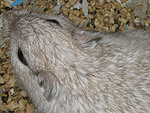
|
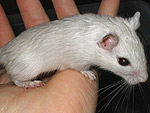 |
|

|

|
Gray
Agouti
|
A-C- E-gg
P- |
|
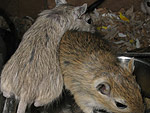
|
The
Gray Agouti may look like an agouti seen in a black and white movie. Some yellow
may show up trought the fur. The "g" gene removes almost all the
yellow color of the hairs. the eyes are black and the belly is white.
Pigment: The eyes are
black and the skin is gray/brown. This is very similar to the regular Agouti.
You'll see the difference as it ages.
Fuzz: It's very easy to see
that it's not a regular agouti. In
the top left picture you can see a normal agouti next to a Gray Agouti. |
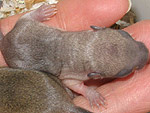 |
|
|
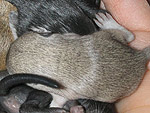 |
|
|
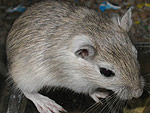 |
|

|

|
Colorpoint
Gray Agouti
|
A-
c[chm]c[chm]
E-gg
P- |
|
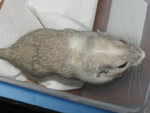
|
The
Colorpoint Gray Agouti is very similar to the Colorpoint Agouti. The only
variation is that the "g" gene removes almost all the yellow color in
the tail. The eyes are black and the belly is white.
Pigment:
Fuzz: Light gray with
tickings. |
|
|
|
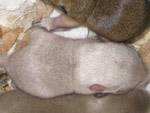 |
|
|
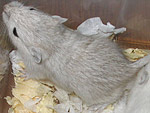 |
|

|
|
Colorpoint
Nutmeg
|
aa-
c[chm]c[chm]
E-G-
P- |
|
|
The
colorpoint Nutmeg is light grey, the eyes are black but some red may be visible
depending of the light.
Pigment: Very light,
the eyes are grey.
Fuzz: Totaly white, beside
the tail that will be light grey. He may look alike very much to the Black Eyed
White. 1 month: The
tail will be grey as the colorpoint Agouti. The ears and tail nose too. 2
month: Just like the regular Nutmeg, un color change will occur. The white
coloration will become grey. |
|
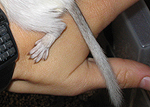
|
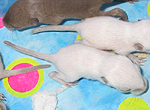 |
|
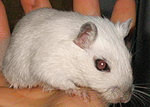
|
|
White
Spots
Some
kind of spots patterns are more rare then others and may also be more wanted
then others. Some also say that spotted gerbils are more docile than non-spotted
gerbils. In genetics, if one parent is spotted, half of the litter will have
spots. If both parents are spotted, 66% of the litter will be spotted. There is
3 different kinds of spot patterns: Spotted, Pied and Mottled. The name is given
by the amount of white on the body and the shape of the white markings.
N.B: The spots make the general colour of the gerbil lighter then the
solid one. Also, the tip of the tail becomes white and the belly too. So, a
black gerbil (who's belly is black) will have a white belly when spotted.
|

|
|
Spotted
|
|
|

|
   
The Spotted gerbils have
only a small diamond on their forehead and sometimes, a small amount of white on
the neck. The white marking on the neck don't go down the shoulders but stay on
the back.
|
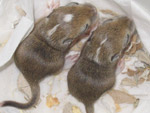 |
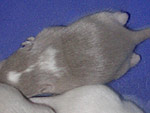
|
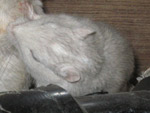 |
|
|
|
|

|
|
Pied
|
|
|
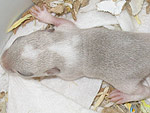
|
   
The
Pied gerbils have white marking on the forehead and also on the neck. This time,
the white of the neck goes down on the shoulder and down to the front paws. Some
white marking can be visible on their lower back.
|
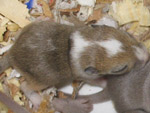 |
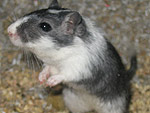
|
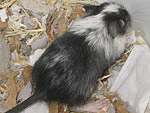 |
|
|
|
|

|
|
Mottled
|
|
|
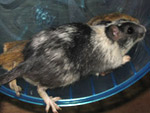
|
  
The Mottled gerbils will
have more white again then the Pied ones.The markings on their lower back will
be more pronounced.
|
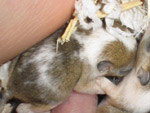 |

|
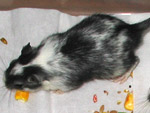 |
|
|
|
|

|
|
Heavy
Mottled
|
|
|
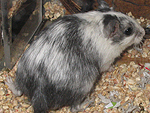
|
  
The heavy Mottled gerbils
have more white markings then the Mottled ones. In some extreme cases, it's
almost impossible to say the real colour of the gerbil, so much there is white
on the body.
|
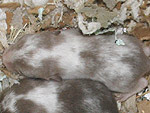 |
|
|
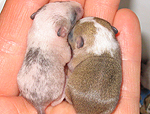 |
|
|
|
|

